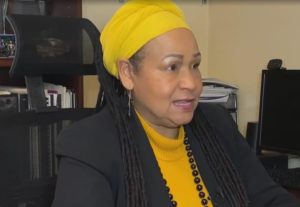Visions in veils – and clear-eyed.
Brides on Broadway
Annual march v. domestic violence
By Gregg McQueen
Marching and chanting, the women in white strode down Broadway, their veils and long trains trailing behind them.
They donned the formal wedding dresses in honor of Gladys Ricart, a Dominican-born Washington Heights woman who was murdered on her wedding day in 1999 by an abusive former boyfriend.
For the past 19 years, the annual Brides March is held on September 26, the anniversary of Ricart’s death, as participants mobilize against domestic and intimate partner violence.
The wearing of gowns has become symbolic with the march, which is organized by several community-based organizations, including the Dominican Women’s Development Center (DWDC), Northern Manhattan Improvement Corporation (NMIC), and VIP (Violence Intervention Program) Mujeres.
The first march took place on September 26, 2001, the second anniversary of Ricart’s murder.
With intimate partner violence incidents on the rise in New York City, organizers said it was imperative to speak out.
In 2018, the NYPD responded to 250,447 domestic incident reports, about 8 percent more than the national average, according to a report from the City Council’s Committee on Women and Gender Equity.
“It’s very scary because it’s done within intimate relationships,” said Rosita Romero, DWDC Executive Director, which offers supportive services to families and women. “It’s something that happens within all classes of society, all races.”
“Domestic violence is really destroying our communities, our families, and we need to do something,” said Dr. Ercilia García, who runs a mental health clinic in Washington Heights.
Following a morning ceremony at Holyrood Church, a group of about 150 marchers set off on a trek through Washington Heights, crossing over into the Bronx before ending up in Harlem.
The marchers chanted, waved signs, and handed out pamphlets with bilingual information about domestic violence and available services.
Marie-Ann Liriano, Ricart’s niece, said the sight of the bridal gowns always gets attention.
“It’s something, to see people’s faces,” she said.
“There’s a lot of emotions with this event,” Liriano added, and noted that the performative aspect is a deliberative measure intended to provoke attention.
“It’s either anger about women [being harmed], or confusion about what we’re doing because people don’t talk about this issue,” said Liriano. “We force the issue out into the open.”
María Lizardo, Executive Director of the Northern Manhattan Improvement Corporation (NMIC), said intense feelings are involved.
“You never have to apologize for being emotional – you never have to apologize for being angry about this,” she said. “We’re sick and tired of this, and we will march every year and we won’t stand down.”

The idea for the Brides March was originated by Josie Ashton, a young Dominican woman from Florida, who was moved by the story of Ricart’s murder. She walked in a wedding gown through several states to draw attention to the issue of domestic violence.
Similar marches have taken place in other cities around the country.
“Today is a call to action for our community,” said Assemblymember Carmen De La Rosa. “I do not believe that we’ll be leaving [behind the] legacy of death. I believe that there is hope.”
DWDC Program Director Katherine Díaz led chants on a megaphone.
“It’s a critical march to be able to support folks, and for people who are living with partner violence. Right now we’re living in a time of #MeToo and a lot of folks are talking about women’s rights, but a lot of times, partner violence feels very isolated,” she said.
“There’s a lot of shame felt by victims of domestic violence,” remarked Kassiel González, Program Assistant at VIP Mujeres.
“They shouldn’t feel shame because it’s not their fault. Marches like these show it’s OK to speak out,” said González. “For those who did not make it, we’re speaking for them now.”
It wasn’t just women who turned out for the march – among the crowd were representatives of the Healthy Masculinity & Manhood Collaborative NYC.

“We’re a collective of different community partners working to engage men and boys in violence prevention work against all woman, LGBTQ, trans and non-gender conforming communities,” said Josue Arguelles, an organizer with the group, which presents workshops focused on preventing gender-based violence.
“Our goal is to be out in the communities and shifting the culture by holding men accountable and having these conversations. This needs to be framed as a men’s issue, too,” Arguelles said. “[Men] do play a role. We do have a responsibility for ending violence.”
García said it was encouraging to see more male representation at the event. “Each year, more men participate in this. They’ve become educated. That’s why it’s important not to stop.”
However, Romero said that fewer people in general have been coming to the march in recent years, as more time passes since Ricart’s death.
“We had about 600 people for the first few marches. When something is new, there is more of an attraction,” she said. “But with domestic violence, people are still dealing with it every day. That’s why we continue to march.”
She called on the city to provide more funding for domestic violence programs.
“We are overworked because of the demand. We need more funding, [more] for the services that we do provide,” said Romero.
Liriano remarked that, ideally, another Brides March should not be needed, if there were to be no incidents related to intimate partner violence.
“The goal is to bring awareness so that it does stop.”
Source: https://www.manhattantimesnews.com/brides-on-broadwaynovias-de-vision/




